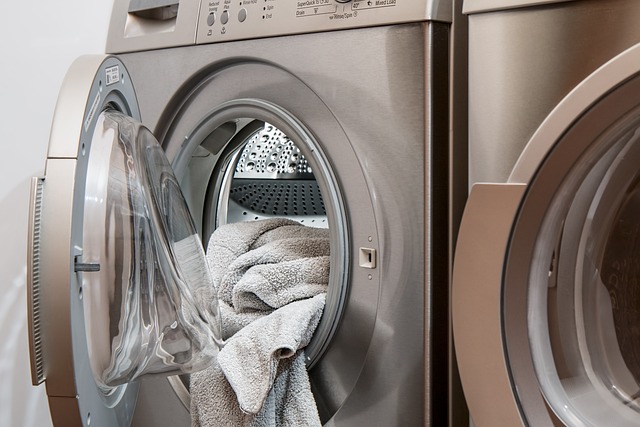A few water drops on the floor may not seem like much initially, but this may soon become a desperate search to find a plumber.
In most cases, water is supplied to the appliance at pressures of sixty, seventy, or even eighty pounds. If the hose gives up during a wash, this will cause the entire room to flood in a matter of minutes.
In such a situation, it will be too late to look for a plumbing company that can help you with the repairs. The only thing you can do is take preemptive measures to ensure this does not happen.
Changing the washer’s old hose will certainly prevent such a situation, and you will be able to use your appliance safely.
So how do you replace a washing machine hose before it breaks? In this article, we will cover everything you need to know.
Types Of Washer Hoses
Before you start your DIY work, you first need to know about the different types of hoses.
- Rubber hoses – Usually used for washing machines in the outdoor area, a rubber hose will get the job done. It may or may not be reinforced with a polyester or rayon mesh. When it comes to indoor washers, though, there is a much better option.
- Stainless steel – You need this for your washer if it is not exposed to weather conditions. The braided stainless steel has flexible plastic encased within it. It is way more sturdy than the rubber one and is barely susceptible to wear and tear if maintained correctly.
What You’ll Need
Now that you know the different types of hoses and which would best suit your needs, let’s see how to install a washing machine hose and what tools you need.
- High-quality hose – We already mentioned the hose, but this is something that any reliable plumber will advise. Investing in a high-quality replacement will save you a lot of time in effort in both installation and maintenance.
- Adjustable wrench or pliers – You will need something to loosen and tighten the connections of the hose. An adjustable wrench is the most versatile tool for this task, but a plier will do the trick if you don’t have one.
- Bucket or towels – Whenever you do a washing machine hose replacement, there will always be some remaining water. Use a bucket to empty the old hose and towels ready to wipe any water drops.
Steps to Replace Your Washing Machine Hoses
Once you gather all the plumbing tools and materials in one place, you are then ready to begin with the task.
Turn Off the Water
Start by turning off the water supply to your washing machine. You can turn off the water to the entire property by switching off the main drain, or if your plumber installed the water supply correctly, you should see two handles that turn off the cold and hot water supply to your washer.
Unplug the Washer
When it comes to your safety, this is the most crucial step you simply can not skip. With dry hands, unplug the washing machine from the electrical outlet. With slow movements, slide the appliance away from the wall just enough for you to get access to its rear end.
Grab your bucket and towels and place them underneath the two hoses.
Disconnect the First Hose
The two hoses behind the washer are for the cold and hot water, respectively. You can start by locating where the hose connects to the washer. Grab your pliers and adjust them to match the size of the fitting. Once done, twist it counter-clockwise until it comes loose.
Before disconnecting the hose from the machine, check where your bucket is and make sure to aim the loose end there. When all the excess water drains, wipe the hose with a towel and move on to the connection at the water supply. Once you remove that, you have successfully removed the hose.
Whether you decide to change only the faulty one or both hoses is a matter of preference. A reliable plumber would change them both, as there is a high chance that the second hose would soon follow the first one.
Connect the New Hose
All tubes are the same size, so your pliers should fit the water supply and machine perfectly. Place the new hose on both ends and tighten it using the pliers. Once both ends are secured, you can move on to add the second hose.
Some washing machines have only one hose for pouring cold water, so you may find the entire process simpler.
Turn on the Water Supply Slowly
Now that everything is in place, it is time to plug the machine back. Again, ensure your hands are completely dry before you connect it to the socket. Do not push the appliance back yet, as you may still have some work.
Start with only one of the handles. Turn it slowly and carefully observe for any leaks. If you notice water dripping, immediately turn off the water supply and check if you have correctly tightened the hoses.
Once you are confident that you have done the washing machine installation properly, fully turn on the handles and slowly push it back to the wall. Be careful not to press too hard, as there should be some space behind it.
To be on the safe side, plumbers would often run an empty cycle of the machine just to observe the process. We suggest doing the same to avoid any unpleasant surprises. Once the cycle completes, if you do not notice any leaks, your machine is now ready for the next batch of laundry!
Conclusion
Knowing how to replace a washing machine hose can save you a lot of trouble.
Various plumbing contractors share from experience that replacing the hose once every three to five years will keep you safe from floods. So, it’s an essential step to maintaining a working washing machine and avoiding accidents.
Whenever you clean the appliance, it is a good idea to peek behind it just to be on the safe side and, should you notice any leaks, ensure that you are ready to replace the hose.





